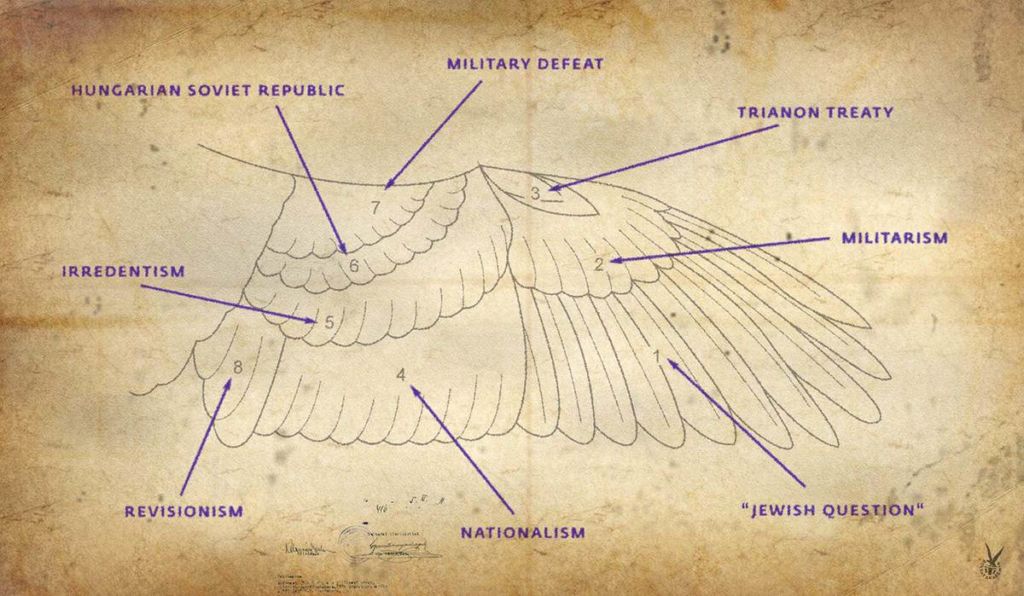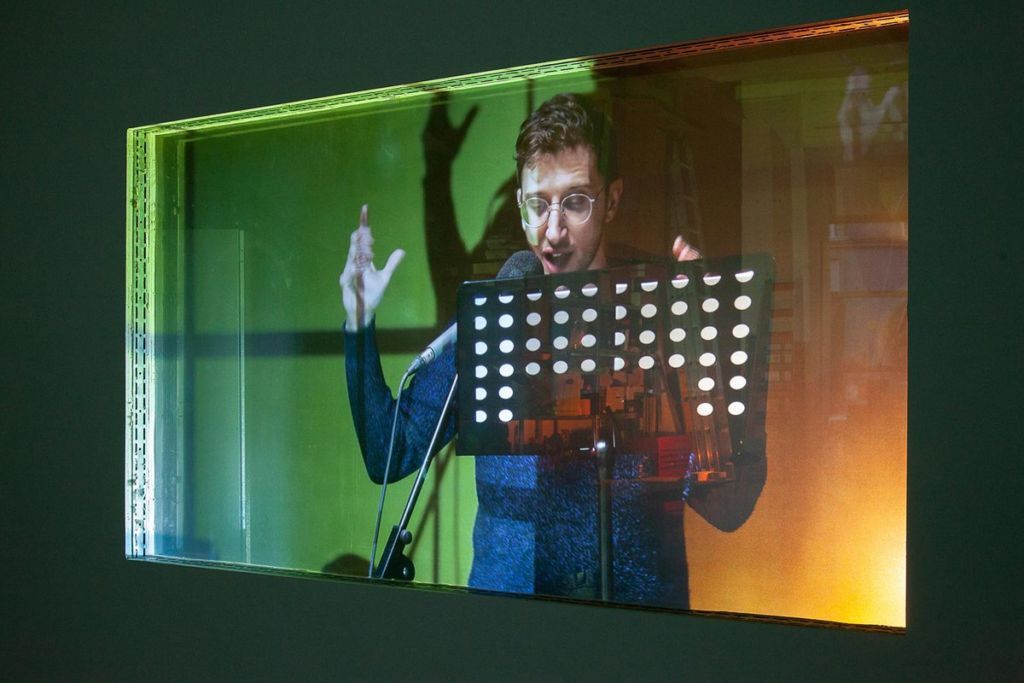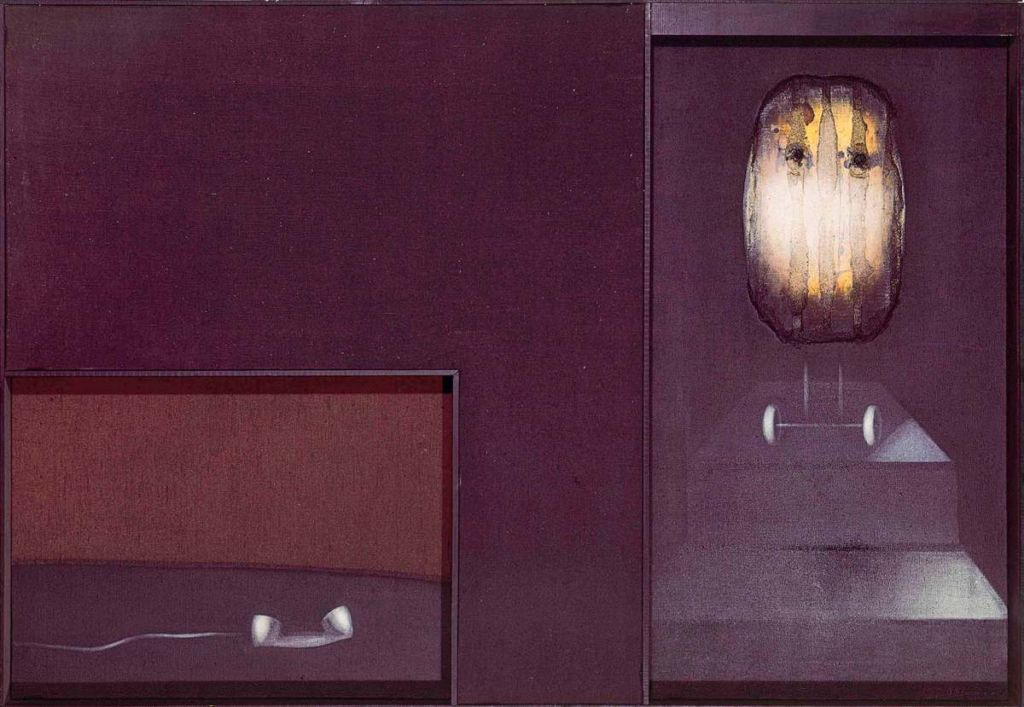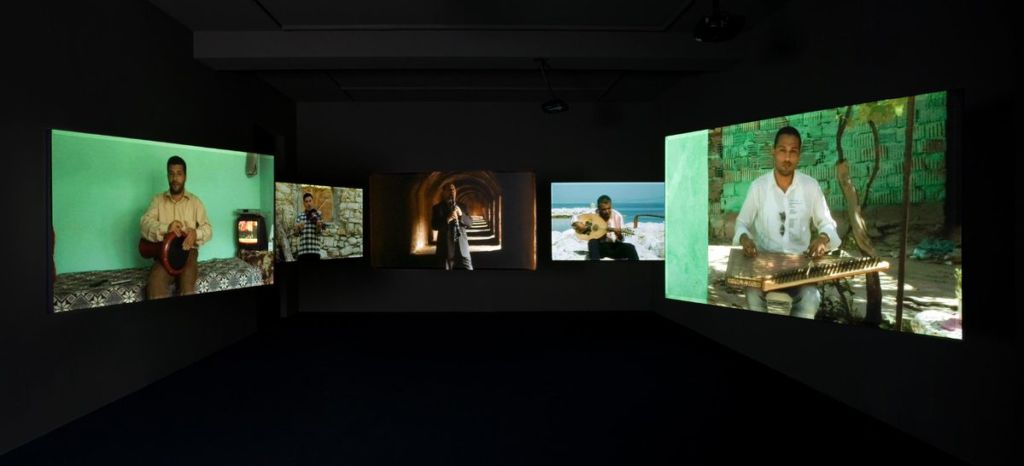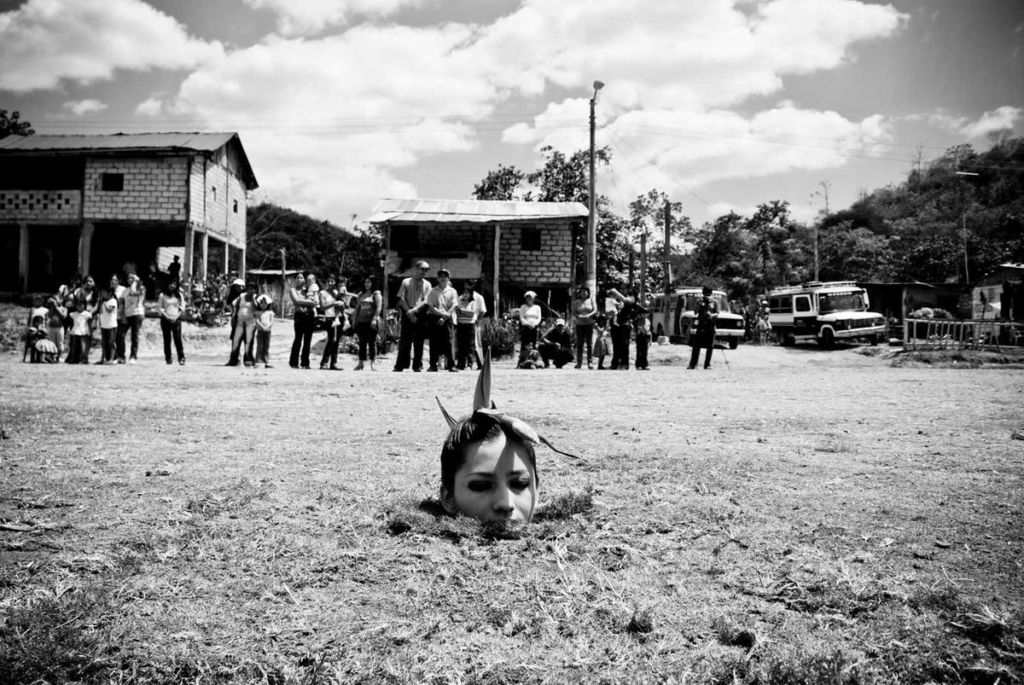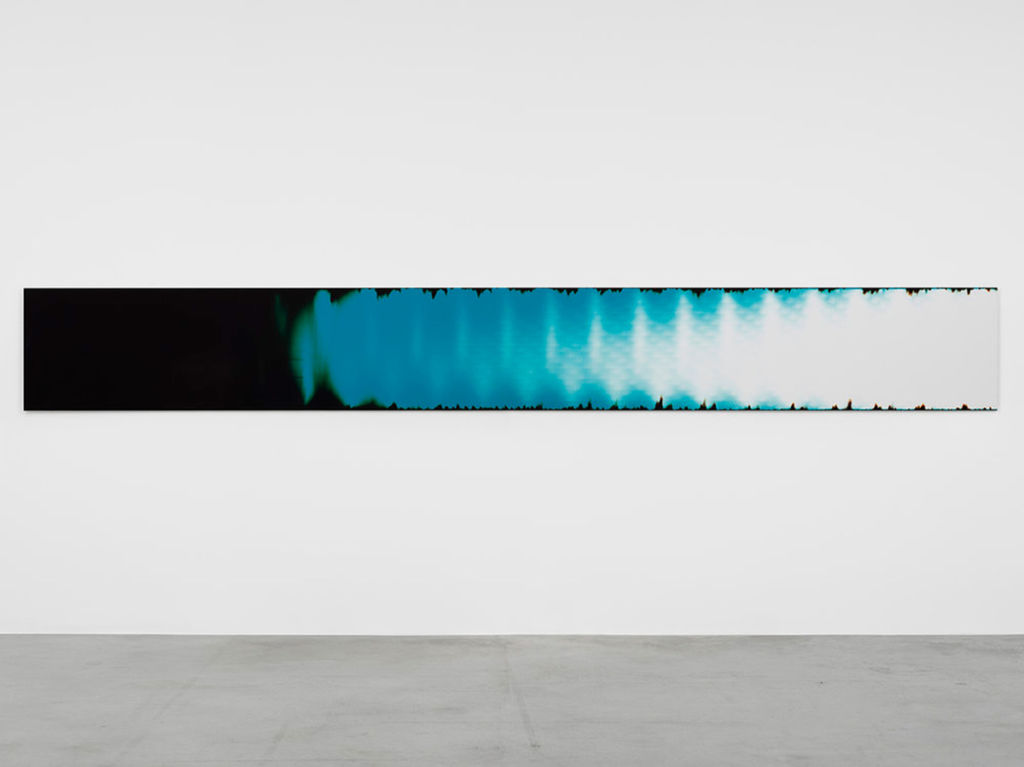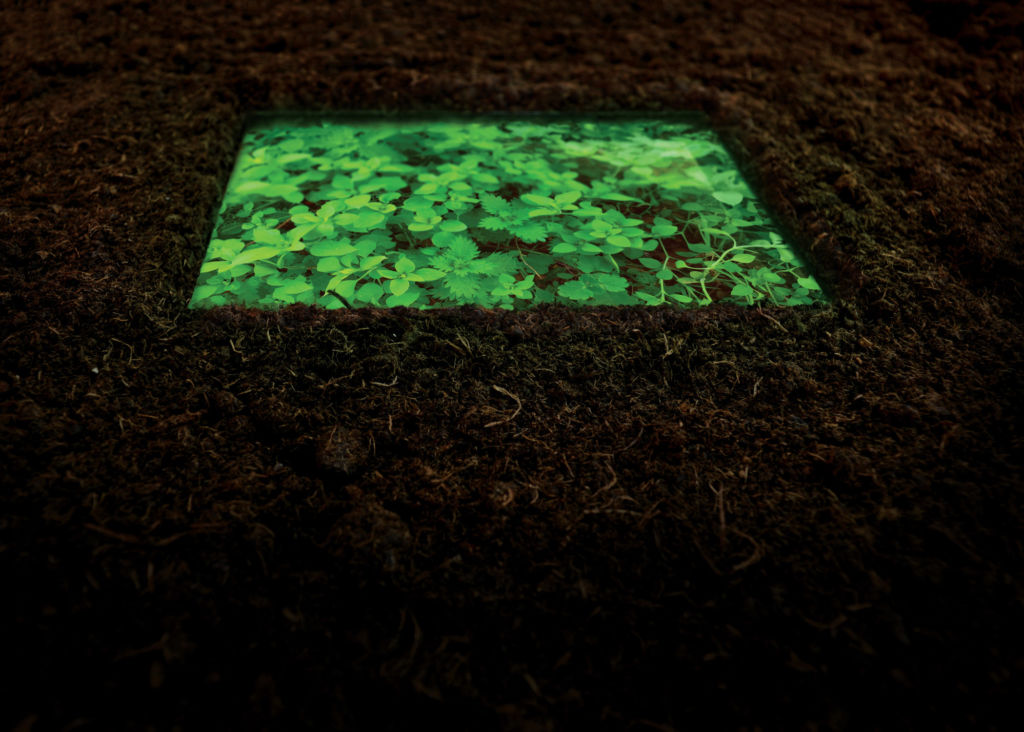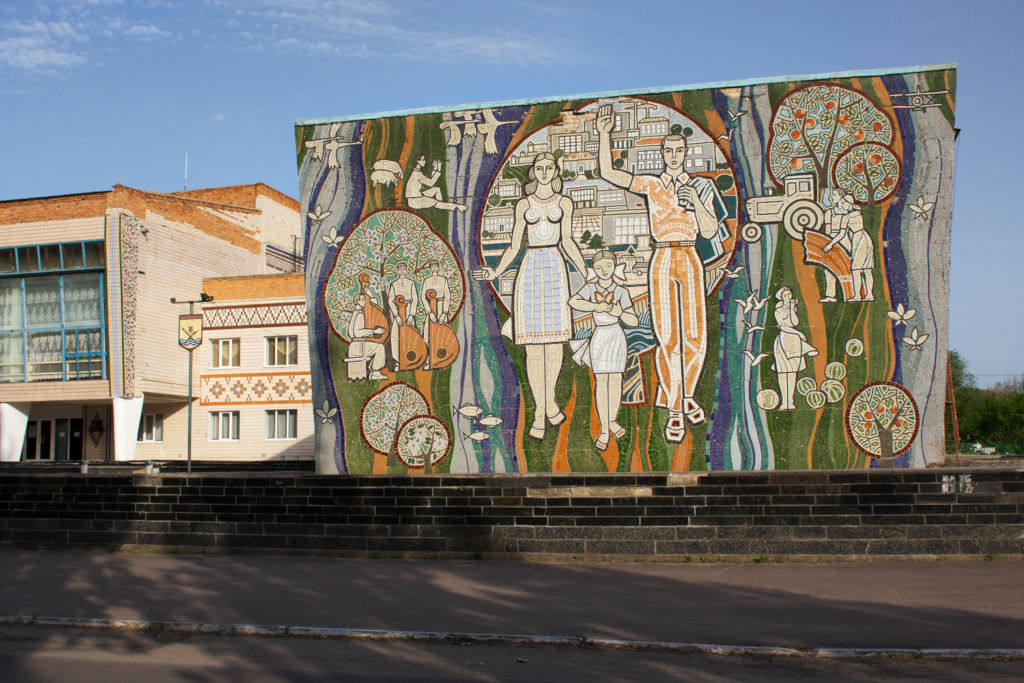Calling out violence against women is a major theme in the art of Sajitha Shankhar. Her choice to speak out for women reflects both her observations of Indian society and her own life experience. Having encountered abuse, she found inner strength and liberation by following teachers who counseled wisdom and encouraged meditation and the value of artistic practice.
(Texte disponible uniquement en anglais)
Sajitha quoted in Amrit Wilson, “Playing with the Moon,” Insqilab: A magazine produced by South Asian Solidarity Group, Spring, vol. 5, no. 1, 1998, 16. I chose not to edit Sajitha’s quotations, since even when her English is not standard and the meaning of her words seems unclear, it is preferable to hear her singular voice in that text.
Which is around 2250 km.
Often, the Bhagavad Gita or “Song of the Lord” is referred to as simply the Gita, a Hindu scripture in Sanskrit, part of the Hindu epic Mahabharata.
Bhamashri Saraswati Devi, Experiencing God (Noida, India: Namya Printers & Publishers, non-dated).
Vijaya Ramaswamy, “Rebels — Conformists? Women Saints in Medieval South India,” Anthropos: International Reviews of Ethnology and Linguistics (1992), 87 (1/3): 133–146. All of the quotations referring to Akka Mahadevi are from this same source.
Email from the artist to the author.
Violence against women in India, a product of gender inequality, is so entrenched that it has a Wikipedia page of its own. Acts of physical and sexual violence committed by men against women are said to be common, often in the context of domestic abuse; but acts of sexual assault and even murder against strangers are reported too. Men are still privileged by Indian traditional culture much more than in Western culture. Newly wed women often have to live with their in-laws and assume the lowest possible status in their new household. Notorious are so-called “dowry deaths,” which refer to married women who are murdered or driven to suicide by continuous harassment and torture by their husbands and in-laws over a dispute about their dowry, wealth transferred from the bride’s family to the groom or his family according to the ancient custom, ostensibly for the bride.
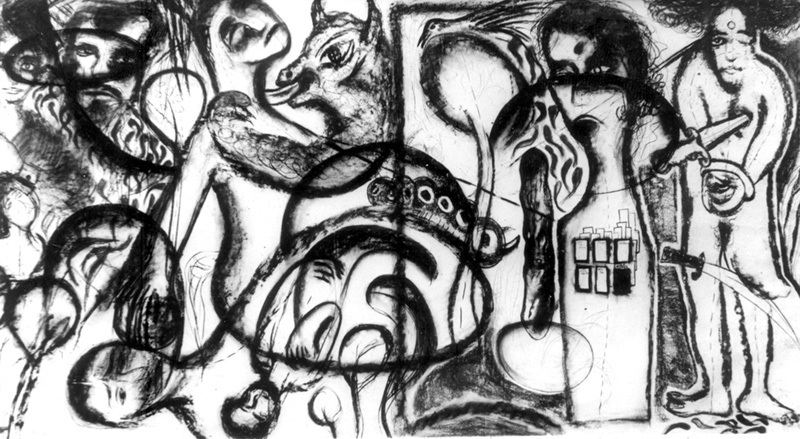
Sajitha Shankhar, Darkness at Noon, 1996, charcoal on paper, 165 x 325 cm
Indian women’s dire situation attracted the attention of Eve Ensler, the American activist playwright, who conducts and sponsors a global campaign, “One Billion Rising”, to stop violence against women. It was in India that Ensler encountered the visual artist Sajitha Shankhar whom I met by chance a few years later, in 2015. Sajitha was born in 1967 in Kumaranalloor, Kottayam, Kerala. Her art grows out of her experience as a female Indian artist. Her work and life impressed Ensler so much that she commissioned Sajitha to make an installation, Tantric Yoni, featured in a conference in Cochin, in the Indian state of Kerala, on February 14, 2013, furthering Ensler’s project “One Billion Rising”. The event’s press release announced that the installation was “symbolic of the inner strength of woman.”
Distressed by Violence
Sajitha’s concern with violence against women in Indian society had already reached beyond her own situation. Years earlier, she had written in her diary, “[…] a young sixteen-year-old girl was cruelly mass raped. My mind is sad and agitated. I cannot think for many days. I cannot sleep for many nights. Finally I started this work, Darkness at Noon.”1 The monumental drawing (183 x 274 cm) from 1996 records the shock of this serial rape and kidnapping, which took place in Kerala. This particular case triggered a huge scandal and battle involving many people including politicians and women’s rights activists. Long after Sajitha responded with an art work, the director Lal Josea made a film in Malayalam, Achanurangatha Veedu, released in 2008, that was based on this case.
Sajitha borrowed the title Darkness at Noon from Arthur Koestler’s first novel, published in 1940, which expresses the author’s disillusionment with the Soviet Union’s version of Communism at the outset of World War II. Sajitha, too, was expressing disillusionment, though it was not with Communism, but with the treatment of women in Indian society. Her agitated drawing, perhaps influenced by reproductions of Picasso’s Guernica, protesting Nazi cruelty during the Spanish Civil War, expresses her horror at violence against women. Her growing awareness that she had to flee such behavior at home eventually launched her on her journey to Delhi in 2007.
Sajitha, then forty, was herself recovering from a failed marriage. She found herself broke in Kerala, her native state, which is located at India’s southernmost tip. She determined that to survive as an artist she had to move to where there was an art market, either Bombay or Delhi. Impulsively, on September 14, 2007, she rolled up some paintings and caught the train for Delhi, even though she lacked enough money to live and was too proud to ask anyone for help. After more than two days on the train, she arrived in Delhi, nearly fourteen hundred miles2 from home, where the language, Hindi, was unrelated to her own, Malayalam. She would have to converse in English.
With no set plans after arriving in the Indian capital, she made her way to the home of friends from Kerala, with whom she lodged for a few days. The next morning, Sajitha decided to pay a call on a well-known artist from Kerala, A. Ramachandran, a figurative painter, more than three decades her senior. Although he knew of her established professional reputation, Ramachandran tried to dash her hopes. He argued that Delhi was too difficult and advised her to return to Kerala. “Ramachandran will say whatever he feels straight to your face,” says Chameli, his artist-wife. Delhi’s other male artists from Kerala virtually shunned her, Sajitha recalls, although some of them had been cordial when her work was being celebrated in Madras (known since 1996 as Chennai).
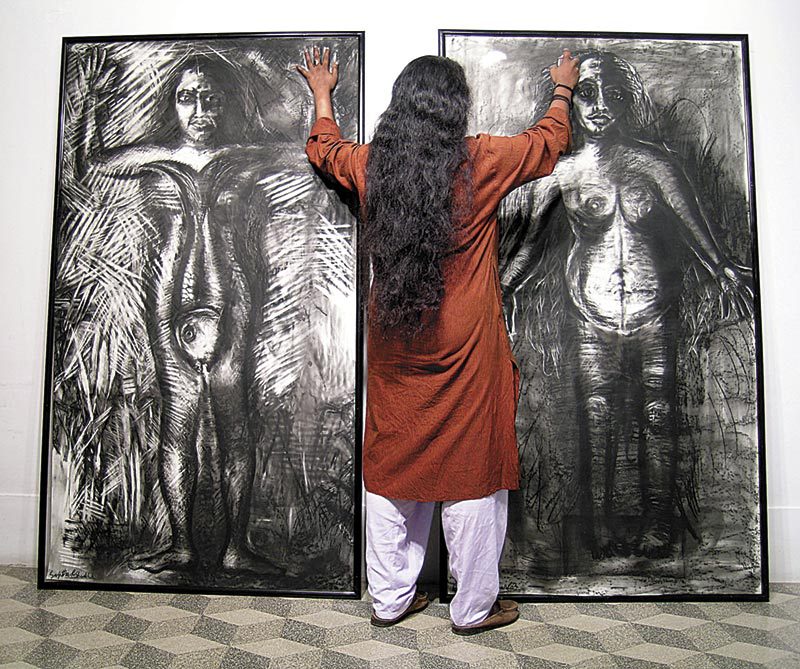
Sajitha Shankhar with her works from the Archetype series, 2003, charcoal on paper, 180 x 105 cm, National Gallery of Modern Art, India
Solutions to Suffering
Things looked up when two unrelated friends each happened to give the suffering Sajitha the same book: an autobiography of Brahmashri Saraswathi Devi, a woman known as Amma, who alternates between her birth home Matom in Neyyatinkara, near Kerala’s capital, Thiruvananthapuram, and one at Noida, close to Delhi. The book’s name is Athma Darshanam [Spiritual Experience], and its protagonist, who lives in the Himalayas and paints, is a very radical woman, adopting the role of a sanyasini, which in Sanskrit describes one who renounces, who lives as a mendicant and ascetic.
As she read, Sajitha recognized a life pattern: Amma meditates and when she awakens, she paints. Sajitha herself, then, the next morning, after meditating, called her friend and asked to meet Amma, whose presence she had felt in her meditation. She was told that it would be very difficult; but when the friend called, Amma said, “Bring her here. I am waiting for her.”
The meeting went very well. Sajitha said very little; but for her, the timing was perfect. She felt that Amma sensed everything. Like Sajitha, Amma was born into a middle-class family in Kerala. They spoke the same language. From her childhood, Amma had pursued God, sitting alone for hours. She preferred a spiritual path, but her family had forced her into marriage, causing her physical and mental torture. She ultimately believed that she experienced the Divine within herself.
Amma advised Sajitha that she had lost only “material things,” but she could see that Sajitha had gained strength from her experience. She told her that her “art was her power,” which Sajitha inscribed into her notebook in Malayalam. Amma invited Sajitha to come back and stay with her if she needed a place. Amma wrote, “When the intelligence is alone, it turns out to be arrogance. Arrogance leads to sorrow. When intelligence remains [in] union with reason, it is Gita (referring to the Bhagavad Gita or “Song of the Lord”4). That is the end of ego.”3 Sajitha drew strength from their meeting, for she considered Amma as “a great painter and writer” appreciated by her contemporaries. For a time Sajitha went every Saturday and Sunday to stay with Amma at her home in Noida, outside of Delhi. They would sit and meditate together.
Driven to Create
Meanwhile Sajitha found for herself a place to work in Neem Chowk at the Garhi Studio of the Indian government’s Central Lalit Kala Akademi, which was open only to professional artists. She thus began again to see fellow artists daily as she went back and forth to the studio. Near the Akademi, Sajitha found a tiny room, only 18 x 12 meters, lacking windows or ventilation, its shared bathroom located in the common hall. She remembers all too well the urine smell outside and that the room lacked a proper lock for the door. It was very frightening. She reminded herself that it was just too difficult to survive as an artist in Kerala. The ordeal lasted fifteen days. She was stoic.
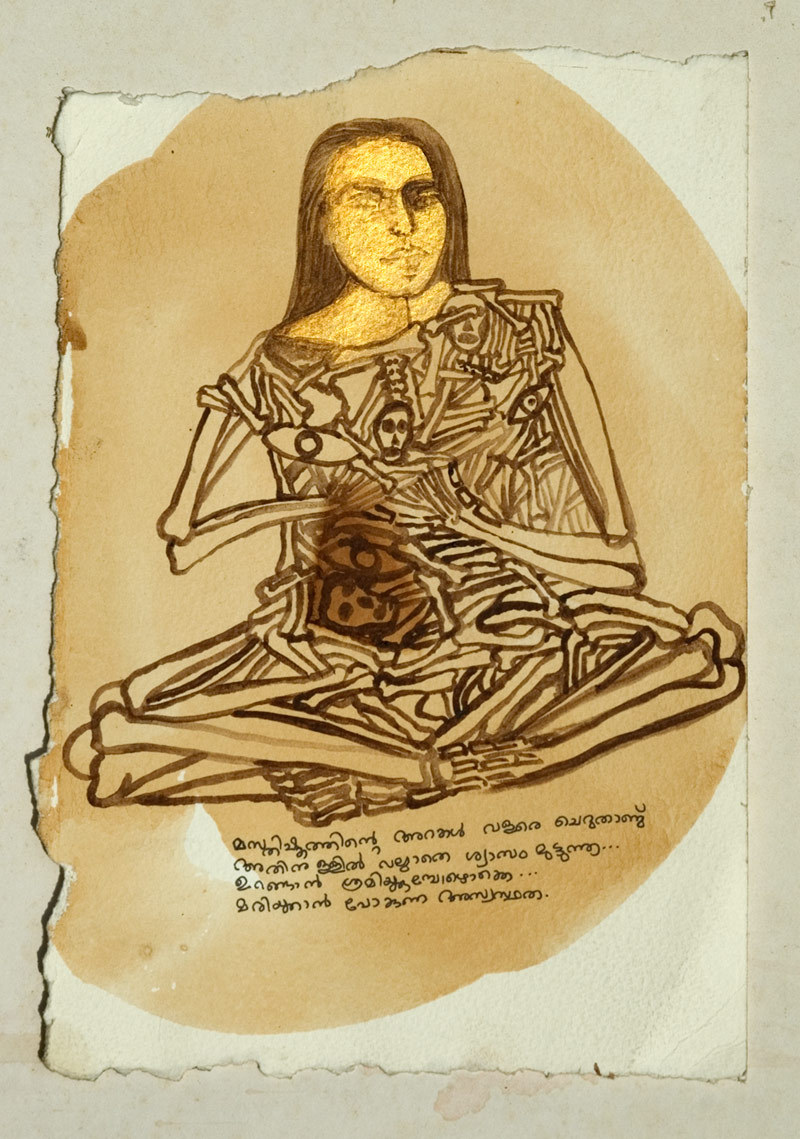
Sajitha Shankar, Alterbodies #7, 2007, work on paper
Inspired by her new bond with Amma and despite the precarious circumstances of her nomadic existence, Sajitha revived and transformed her artistic idiom. She returned to drawing in charcoal on paper, producing a major work. Pushing her method to a new level, she placed a large sheet, cut from a roll of handmade paper (244 x 183 cm), on her studio floor and stretched out on the paper. Then she got an artist from a neighboring studio to help her by tracing the outline of her body—as her daughter (and only child) had done for her in 2003, when they lived in the Cholamandal Artists Village in Madras. At that time, in the very moment when Sajitha was working on three of those life-size self-portrait figure drawings, the curator of the National Gallery of Modern Art in Delhi happened by and snapped them up for its permanent collection. She called these works Archetypes, inspired by Carl Jung’s concept of universal, mythic characters that reside within the collective unconscious of people the world over.
The 2007 drawing, produced in Delhi, represents three women. They are derived from Sajitha herself posing in two different positions, and represent feminine forces merged into one female body. These female forms stand on the earth, which is covered in mushrooms. Along the vertical borders, are circular cosmic forms that echo her earlier series Navagraha (“nine planets” in Hindu mythology).
Historical Inspiration
Sajitha’s new drawing caught the interest of Ajeet Caur (born 1934), a well-known Punjabi Indian writer of fiction based on social-realist themes such as the experience of women in familial relationships (with both their fathers and their husbands) and their position in society. Ajit, who is the mother of Sajitha’s friend, the artist Arpana Caur, looked at Sajitha’s picture and thought of the South Indian twelfth-century poet, Akka Mahadevi, considered a Hindu saint and a prominent figure in the field of female emancipation. Ajit linked Sajitha’s work to oppressed, exploited, and alienated women who turned to spirituality for self-expression which is a time-honored tradition in India.5
Sajitha had in fact been reading Akka Mahadevi’s poetry, translated into English (from Kannada, the language from the South Indian state of Karnataka). Akka Mahadevi was also the subject of a play that Sajitha had seen produced at an Indian festival, in Valladolid, Spain, where her work was exhibited in 2000. Acknowledging the similarities between the poet’s writings and her drawing, Sajitha called her work, Remembrance of Akka Mahadevi, 2007.
Contemporary Hinduism embraces such female rebel-saints as Akka Mahadevi, who is remembered for rejecting King Kausika, leaving his palace naked, covered only by her long hair. We see such an image of a nude woman covered only by her long hair three times in Sajitha’s life-size charcoal drawing. In the face of her own conjugal estrangement, this Saint’s flagrant denial of women’s sexual obligations and bold refusal to conform to sexual expectations must have seemed liberating to Sajitha, who goes on to explore this theme in a series of her artworks that she calls Alterbodies.
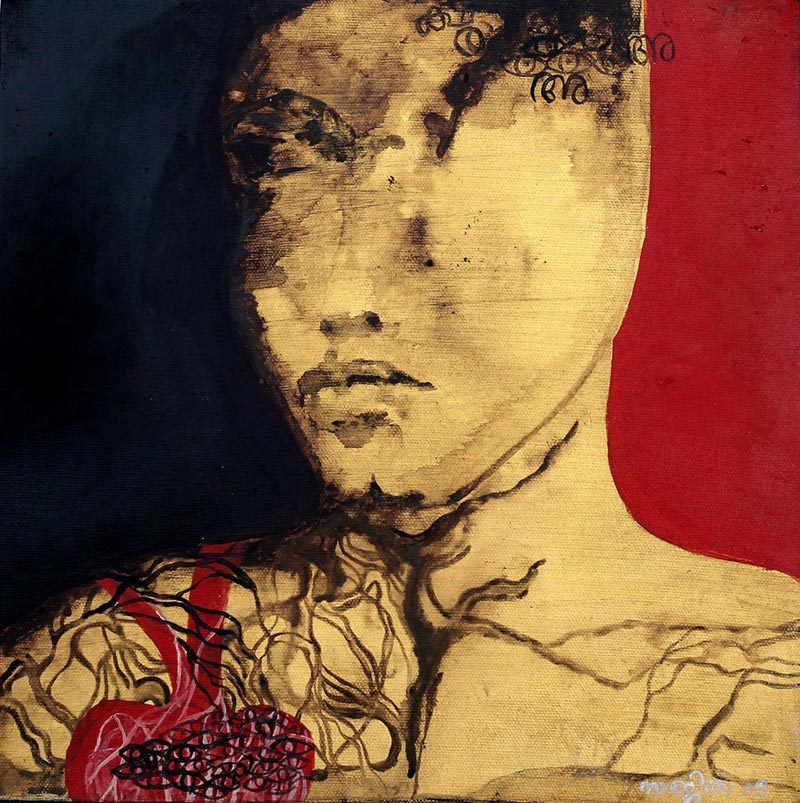
Sajitha Shankar, Alterbody series, 2009, acrylic on canvas, 30,5 x 30,5 cm
Sajitha found in Akka Mahadevi’s poetry a radical re-examination of the role of women in society. The poet’s imagery challenged usual ideas of sexual identity. She elevated creation beyond the masculine power of the god Shiva to emphasize the feminine basis of all of creation: “I saw the haughty master, for whom men, all men, are but women, wives.”
Spiritual Renewal
Remembrance of Akka Mahadevi was Sajitha’s first production after the break caused by the trauma around her failed marriage. Now she embraced life with a renewed sense of energy and determination. She refers to this work as a “lucky” one, since good things were to come from the people who saw it and responded to its imagination and creative energy.
From then on, Sajitha began to regain the career momentum lost during years of personal trauma that forced her to flee and had marred so much. Working on her large paintings in the Akka Mahadevi series of women archetypes, Sajitha wrote in her journal on the second day of January 2008: “What all disappeared from the earth, the fire never dies. Wherever you touch, there will be fire. Each and every person is a miniature of the universe. A human is like fiction. I feel that primitive man is still living. Without knowing anything, the mind sometimes acts like a person who cannot see. The mind is a book without words.”6
At this time, Sajitha returned to her practice of using her own body in her painting. She wrote, “The way to knowledge is our body,” the same day she drew a sketch of herself “in a meditating pose” in her diary. The next day, she observed, “When you enter into your own body u can see the whole world.”
Sajitha was then reading Satprem’s 1982 book, Mind of the Cells: Or Willed Mutation of Our Species, an English translation of the French author, who was a disciple of Mirra Alfassa, known to her followers as “The Mother.” Born in Paris in 1878, Mira Alfassa ended up “The Divine Mother,” in charge of the Sri Aurobindo Ashram in Pondicherry, on the southeast coast of India, where she died in 1973. This book documents her lifelong project of trying to achieve physical change through spiritual consciousness—transforming her body in order to permanently overcome pain, disease, and even death itself. Mira Alfassa believed that cells had a consciousness of their own, and if she could reorient them, they could avoid decay, disease, illness, and death. Sajitha continued her own searching for answers.
Sajitha was also nurturing herself by reading about women artists, many of whom were American, often associated with feminism. She discovered, for example, the sculpture of the American Nancy Graves, who appealed to Sajitha through their shared interest in linking nature and anthropology to art. Sajitha liked in particular the work of the New York–based (French-born) artist, Louise Bourgeois, whose work was inflected by both surrealism and feminism as Sajitha’s was also said to be. Sajitha could see that Bourgeois often reflected traumatic psychological events from her childhood in her art, especially her father’s infidelity. Sajitha found much to admire, too, in the art of the American activist and feminist painter, Nancy Spero, who in 1976 realized the series Torture of Women inspired by reports of Amnesty International about dead or missing women.
It was out of this ferment that Sajitha created a series of works, for which she coined the name Alterbodies. She started with a small figure drawn on paper: a self-portrait seated in Yoga or lotus position. Her body appears like a skeleton, composed of bones, without any flesh. Below this figure are lines of her poetry written in Malayalam: “The rooms of the brain are too small. Whenever I tried to sleep, I felt suffocated and felt like I was dying.” This woman, Sajitha knows, cannot contain her thoughts of the past, which are too painful. She must, through meditation, learn to live in the moment.
Although Sajitha’s inspiration for this figure was the intensity of her own experience of suffering and of meditating with Amma, she also appears to have absorbed earlier images by such artists as Frida Kahlo or Robert Rauschenberg. Kahlo depicted skeletons and skulls, seen so often in Mexican folk art, and Rauschenberg utilized X-rays making his own bones visible in some of his early artworks. Sajitha reflects her own experience practicing meditation, an intrinsic element in yoga. Yoga is said to have evolved in India as a means to transcend suffering. Thus, Sajitha depicts herself as continuing an ancient Indian tradition.
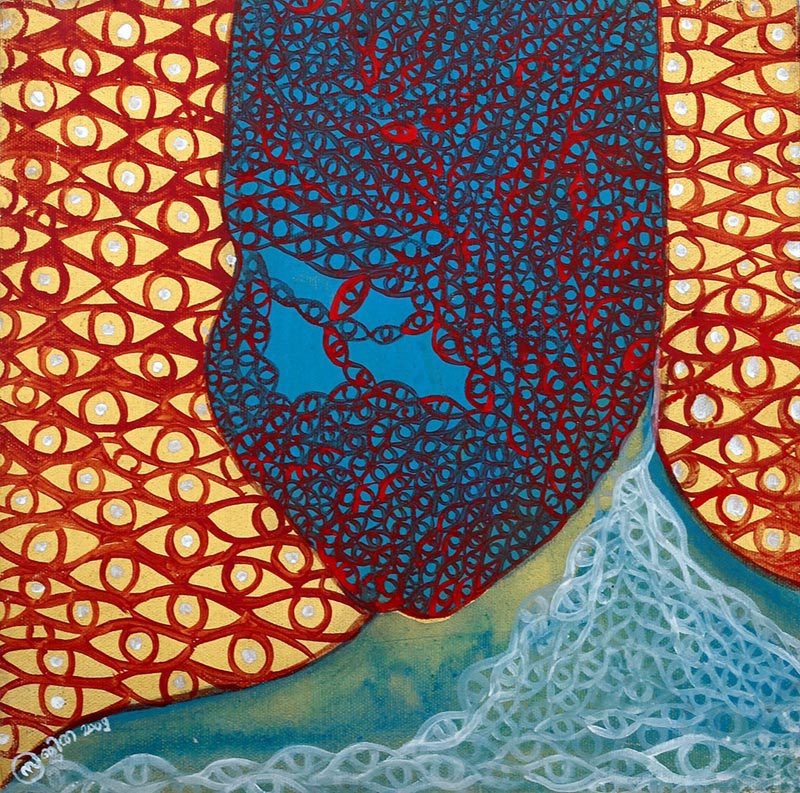
Sajitha Shankar, Alterbody series, 2009, acrylic on canvas, 30,5 x 30,5 cm
This same lotus position is used in representing not only Shiva, the meditating ascetic god of Hinduism, but also Siddhartha Gautama, the founder of Buddhism; as well as the Tirthankaras (Teaching Gods) in Jainism. Sajitha’s adaptation of this posture is poignant, evoking her own pain in life. Throughout her mature artwork, Sajitha continues to mine Indian culture for its clues to perception and to rising above the suffering of existence. Through her exceptional creativity and determined spiritual quest, she has managed to overcome considerable obstacles, and is continuing to create a remarkable body of work.
Meditation into Art
As she pursued the practice of meditation and Yoga very deeply during her time in Delhi, Sajitha reached a calmer place. This enabled her to begin anew. She says that she is “exploring something beyond sexuality, beyond the exterior, the skin,” in the series Alterbodies. “What are the alternative possibilities?” she asks. “My works: childhood memories, autobiographical, women and reality, women and nature, women emancipated, then women and mother archetypes, then, I slowly evolved and reached Alterbodies. I have only just begun. There are many amazing possibilities to explore. I am exploring it through my own body. I use my own body as a form. I started from my skull itself—the skull series.”
She began painting a series of small canvases, starting with variations on the skull, which she thought was her own. She took the subject and went deeper and deeper into the matter. When she drew the bare skull, it always seemed to be laughing. She slowly began “adding flesh, bit by bit to each of her skulls—half with flesh and half without. Still the skull seemed to be laughing beyond the senses. It was laughing.” Though the skulls were laughing with her brain and her body, they seemed genderless. Only after she gave the skulls her features, the five senses, did they stop laughing. “Smell, sight, taste, hearing, and skin for touch.” But the series was “not about death; it was about life.” For her, the skulls transcended their flesh and their expression of gender and sexuality, so that she was no longer frightened. She calls this experience “the long journey” of when she began her series, Alterbodies.
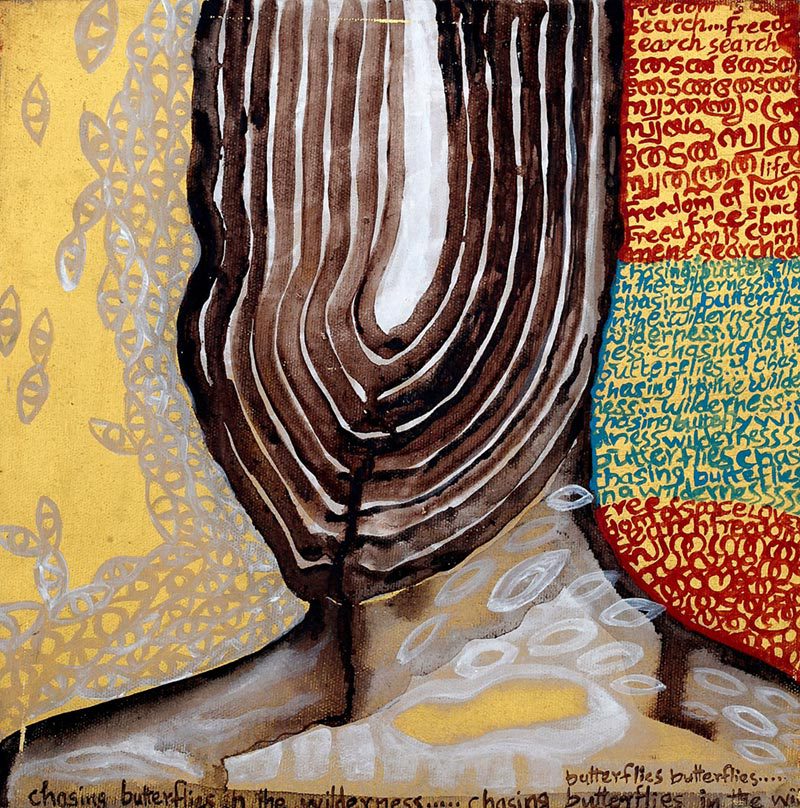
Sajitha Shankar, Alterbody series, 2009, acrylic on canvas, 30,5 x 30,5 cm
When she moved on to use her face in an abstract self-portrait in 2009, she included writing in Malayalam. She moved the heart from left to right to make “a spiritual heart.” This was a concept she took from the man she considers her Guru, Ramana Maharshi (1879-1950), an influential Indian philosopher and a Hindu sage born in the South Indian state of Tamil Nadu, where Sajitha lived during her marriage. The idea of painting the heart as if seen through an X-ray, however, also suggests that Sajitha was again looking at Frida Kahlo’s work, especially her famous painting, The Two Fridas, from 1939. Both artists experienced and expressed suffering.
Like Frida, Sajitha makes many self-portraits, focusing on her intuitions and awareness. On one painting from a nine-part Alterbodies series of her head, she has written “Nissanghatha” in Malayalam, which means “non-attachment.” “It’s a kind of reflection of the city on the body,” she explains. “How sensitive we are, we are unaware of this.” Sajitha survived her self-imposed exile in Delhi, turned it into triumph, and returned home to work in Kerala in 2010.
Productive Response to Violence against Women
Sajitha’s experience as a woman artist in India follows in the tradition of previous generations of Indian women artists, who have had to struggle to work despite violence against women in society and often in their own homes. Such violence helps to maintain discrimination in the world of art. Not surprisingly, one can find a sharp focus among Indian women on issues of gender conflict, displacement, and violence. Some visual artists, from the well-known Nalini Malani (born in 1946) to those of the next generation, such as Sajitha Shankhar, share concern with the oppression of women and have managed to weave this caring into their art works. They have also turned to lives of social activism as well as artistic expression.
Sajitha, taking hold of the inner strength she found within herself, has continued not only to make her art, but to work as an activist on educational projects with local tribal women and children in rural Kerala. In 2010, she turned her beautiful studio-cum-residence in Kallar, on the banks of the Kallar River in Kerala, into the Gowry Art Institute, intended to focus on inter-disciplinary studies in art and to serve as “a place for artists, writers and poets to converge and create works of art.” From this base, she organizes educational outreach into this rural community.
Sajitha’s choice of Kallar was personal and she has not kept the reason private: “It was a search for ‘A Room of my Own’ that led me to discover this place on the foothills of the Agasthya hills,” she remarked, referencing Virginia Woolf’s classic essay exhorting women to pursue their creative talents despite the obstacles put in their way.
Acknowledgement
I wish to acknowledge and thank the artist, Sajitha Shankhar, and the Fulbright U.S. Scholar Program. In 2015-2016, I held a Distinguished Fulbright Chair based in Kerala, India, during which I lectured on American art across India and conducted research on contemporary Indian art.
Editor: Vincent Simon
Sajitha Shankhar, Tantric Yoni, 2013, installation for the One Billion Rising event, Kochi, Kerala, India.

